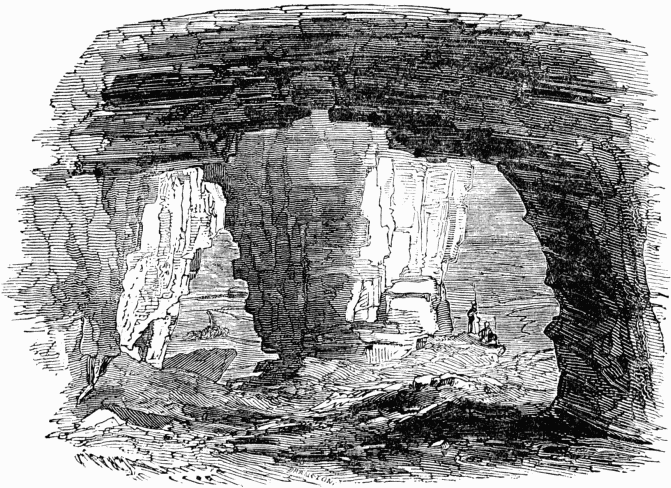TRANSCRIBERS' NOTE
The cover image for this e-book was created by Distributed Proofreadersand is being placed in the Public Domain
THE IRISH PENNY JOURNAL.
| Number 2. | SATURDAY, JULY 11, 1840. | Volume I. |

THE CAVES OF KISH-CORRAN.
Among the many wonders of Ireland, as yet undescribed andlittle known, even to Irishmen, beyond their immediate localities,the subject of our prefixed illustration has every claimto find a place, and to attract our attention as a subjectequally interesting to the geologist, artist, and historian.That it should have hitherto remained unnoticed, as we thinkit has, while objects of the same description in other localitiesless remarkable and interesting have been repeatedly described,may be attributed chiefly to the circumstance of itssituation being remote from any leading road, and in a wildand rarely visited district of country, namely, the barony ofCorran, in the county of Sligo. Of this barony, the mountaincalled Ceis or Kish-Corran, is the most striking geographicalfeature. It is composed of tabular limestone; has aflat outline at top, but is precipitous on its sides, and rises toan altitude of upwards of a thousand feet. To the travellerjourneying from Boyle to Sligo it must be a familiar andpleasing object, as, after passing the little town of Ballinafad,it offers, for some miles of the road towards the westand south-west, the charms of a mountain boundary in contrastto the rich woods of Hollybrook, and the delightfulvistas of the water of Lough Arrow, or Arva, which skirtthe road along the east. But the most precipitous and noblepoint of Kish-Corran is presented to the west, and is notseen by the traveller on this road, which must for a time beabandoned to enable him to see it, as well as the wonderfulcaves which open on its face, and to which we have now tocall the attention of our readers. On this western side, themountain, to within a hundred feet or two of its summit, presentsa green but boldly sloping grassy face, formed of thedebris of the rocks above, which rise perpendicularly, and lookmore like a wall—lichen-stained and ivy-decked—formed bythe Cyclops or giants of old, than creations of nature’s hand.And such impression is increased in no small degree by thelofty and magnificent caves, which present themselves likedoorways, and lead into the inmost recesses of the mountain.It is of one of these entrances, and the most remarkable forgrandeur, that our illustration attempts to give an idea. Itsheight is no less than twenty feet. How far the caves extend,we are unable to speak with certainty; they are undoubtedlyof great extent, and, if the local accounts are to be trusted,reach even to the opposite or eastern side of the mountain,and contain lakes of unfathomable depth, and spars of unimaginablebeauty.
A spot so striking to the imagination could not be, in Ireland,without its legends of a romantic and singular character;and some of these are of a most remote antiquity, and connectedwith the earliest legendary history of our country. Inthe ancient topographical tract called the Dinnseanc